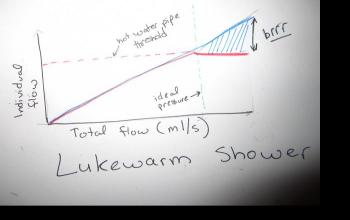This isn't really a K-fail, more of a K-mystery.
For months, I was dealing with a strange phenomenon. When I turned on my shower, I would have medium-hot water for approximately two minutes, at which point it would turn cold. You can imagine how unpleasant this was in an unheated bathroom in the dead of winter. My hygiene may have suffered slightly. I found myself showering at the gym a lot-- choosing the stares of old Korean women over the inhumane conditions of my own shower.
It wasn't until about 3 weeks ago that a friend of mine let me in on what is apparently an open secret in Korea: When showering, don't turn the water pressure on all the way. Only turn it about 80% on. I tried it, and was treated to a scalding (seriously: face-meltingly hot) shower that lasted (seemingly) forever. I was appalled. I still am. There is no logical reason for this to be happening.
First of all, my apartment is heated by hot water. It's pumped through the pipes under my floor that make up the ondol system I have gushed (pun intended) about frequently. My floor heats up approximately to the temperature of the heated seat in a car. This is no lukewarm rubber water bottle. That water is hot.
It stands to reason, therefore, that there would be enough of the stuff to give me more than 2 minutes of a moderately hot shower at full pressure.
But say there isn't. Let's say that there is a limited quantity of hot water, and the pressure at which I run my shower determines how long I can take a hot shower. The math still doesn't add up. By reducing my water pressure by about 20%, I figure I should be able to extend my shower by about the same amount. Along those lines, the more I reduce my pressure, the longer my shower should be. But so far, I haven't found a significant difference between, say 50% water pressure and 80% water pressure. They both result in a very hot shower lasting around 40 minutes. Yet, if I turn the water up to full pressure, it turns cold in mere moments.
Let's keep my carbon footprint out of this for now. It's been really cold here, ok? Like... really, really cold. Also remember that I was taking 2-minute showers for months.
This is so baffling to me that I even tried to figure out a mathematical formula to illustrate the relationship between water pressure and length of hot shower. Seeing as I haven't taken math since junior year of high school, I obviously failed miserably.
Follow up at:
K-Mystery Solved! (Caution: Science Ahead)





Comments
Re: K-Fail: The *Other* Hot Water Problem
I'll definitely try reducing the pressure by 20% tonight. Before winter came, I used to spend about 15 minutes in the shower but nowadays 3 minutes seem long enough. I dread going to shower at home because of that.
Re: K-Fail: The *Other* Hot Water Problem
I think it functions differently from what you explained. Back home we use a geyser, (I'm assuming you do too) that boils a set amount of water ready to be used at a given time.. Most apartments in Korea though use burners. How I understand them to work is that water flows over a heated panel or flame, heating up the water for a morning shower. However the more water that runs over the heating surface the less it would actually heat up the water. A bit like the time it takes to boil 1litre vs 2litres of water. The perfect equilibrium is reached between the actual heat of your water and the amount of water needed to take a shower(and not be all dry arse) is 80%.
I hope that makes sense.
Re: K-Fail: The *Other* Hot Water Problem
I had this very same problem recently and ventured to open the little room in my new apartment where the hot water heater was supposed to reside, thinking my pilot light had gone out or that I would perhaps get some magical inspiration from the hot water heater fairy. Imagine my surprise when I found...there was no hot water heater! At least, not one like I was expecting.
What was later explained to me, via my coteacher through the maintenance guy that finally came and fixed my problem (the pressure was too high), was that Korea uses something called a tankless water heater system. Curious, I went off to do research. Basically, instead of maintaining a constant tank of hot water, the system runs cold water through a heating element. It's supposed to be more energy efficient, of course, but can have issues with constant temperature.
For a much better and more technicaly correct explanation than I could ever give, I refer you here:
http://energy.gov/energysaver/articles/tankless-or-demand-type-water-hea...